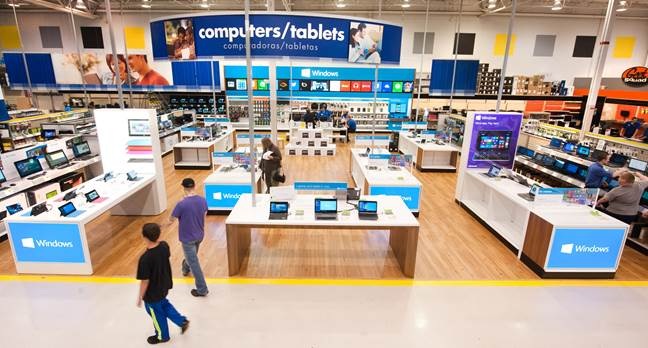Can Microsoft's mini-stores save Windows 8?
When Samsung made its move to install 1,400 store-within-a-store concepts at Best Buy back in April, we recommended that Microsoft take note. And take note, it did: Today Microsoft and Best Buy announced the launch of a new Windows Store at 500 Best Buy locations in the United States and another 100 in Canada, for a total of 600 in North America.
Instead of a store-within-a-store concept (which both Apple and Samsung now employ at Best Buy), the Windows Store represents a complete take-over of the PC department. Windows Stores will effectively replace the computer department at these 600 Best Buy locations. But they will offer a wider range of Microsoft consumer products (PCs, tablets, and accessories, of course, but also Office, Windows Phone, and even Xbox) than just PCs.

Microsoft’s Windows Store represents a vital strategic step forward in its retail strategy and ought to yield some benefits. At the same time, the move should have happened several years ago; it isn’t quite as ambitious as it might have been, and Microsoft will have to work hard to overcome legacy practices within the Best Buy ecosystem.
Why is this move essential for Microsoft? Put simply, the non-Apple Store North American retail channel for consumer electronics is broken … and it’s getting more broken:
Best Buy isn’t presenting the best experience for buyers of consumer electronics. Beset by showrooming, the retailer entered a race to the bottom with its recent price guarantee. A spiral of disappearing margins has made direct investment in improving its stores challenging. At the same time, its managers have resisted attempts to create better, more integrated shopping experiences — showing how multiple devices work together as an ensemble. Finally, the company has been long addicted to the incentives paid by vendors seeking preferential placement, like pricey end-caps.
The unprecedented explosion in new computing form factors confuses buyers. The Windows ecosystem has exploded with new form factors. From Windows 8 touchscreen convertibles (like Lenovo’s Yoga) to hybrid PC/tablets with detachable keyboards (like Microsoft’s own Surface Pro) to pure tablets running Windows RT (like Dell’s Latitude 10) to giant tablet-like desktop convertibles (from HP, Dell, and Lenovo) to forthcoming 7” and 8” Windows 8.1 devices.
The sheer diversity of computing form factors, chip options, and use cases buyers face is dizzying — particularly in the micro-segmented tablets, hybrids, and convertibles space, which encompasses everything from Apple iPad Mini to Microsoft Surface Pro. (See Figure).

Getting a grip on Windows 8 options
Without a customer-centred, richly curated shopping experience, consumers just can't figure out what all the Windows 8 options represent.
Which are laptop replacements, and which are adjunct devices? Which form factors can truly be thought of as tablets, and which are more “PCs plus touch”? To navigate the confusing diversity of choice, buyers need: 1) compelling displays where they can touch/feel, try out, and, most importantly, determine how a device would fit into their own lives, and 2) compelling sales conversations with well-trained store associates. These are some of the needs the Windows Store will attempt to address.
Microsoft’s move will upgrade its retail capabilities significantly, but it’s not as powerful a move as rolling out 600 Microsoft Stores (however expensive) would have been. Microsoft will gain a powerful asset in selling Windows 8.1 devices and other consumer offerings — but how much the Windows Store can move the needle on the overall market remains to be seen.
The most compelling aspects of Microsoft’s move include:
- The reach of the deal. In addition to the 600 North American points of presence, the fact that Microsoft is essentially taking over Best Buy’s imperfect PC department shows appropriate ambition.
- Microsoft’s retail expertise. Microsoft isn’t entering this world blind; the company will build upon years of research (at its Retail Experience Centre in Redmond) and of trial-and error (at its 65 Microsoft Stores) to engineer a better experience than shoppers have received at Best Buy.
- The opportunity to craft an experience. If done correctly, the Windows Store will upgrade the shopping experience with improved messaging, mise-en-scene displays, and superior store associates.
- A classroom for the brand proposition. Even if showrooming behaviours persist, Microsoft can upgrade consumers’ understanding of its brand and products, which will reinforce its platforms.
Where Windows Store faces challenges
- Channel conflict: Microsoft Store vs. Windows Store. Buyers familiar with Microsoft Stores could face disparate experiences when visiting a Windows Store. For example, Microsoft Stores offer ample technical help and customer service at their Answer Desks. Will shoppers with PC problems be sent to Best Buy’s Geek Squad instead?
- Sales associates will be Best Buy employees. When Samsung announced its store-within-a-store experience, one critical detail stood out: Samsung-employed sales associates. Microsoft will leverage a mix of 100 Microsoft-employed specialists, but more than 1,200 of the sales associates will be Best Buy employees trained by Microsoft. Can these non-Microsoft employees live up to necessary quality standards?
- OEM conflicts within the Windows ecosystem. Microsoft’s Windows OEM partners (HP, Dell, Lenovo, Acer, Asus — the companies that make PCs and tablets) already have a bone to pick with Microsoft concerning the Surface. How will they feel about having to compete with Microsoft’s own hardware (Surface, Surface Pro) in a Windows Store managed by Microsoft itself? Similarly, how will they deal with changes to in-store marketing opportunities like end-cap displays?
- Potential buyer apathy. Finally, if the Windows Store doesn’t offer a genuinely upgraded experience, will buyers care? If it’s only marginally better, will buyers care?
All in all, the opportunities outweigh the challenges with this move. But Microsoft will not rise to the strategically stellar position currently occupied by the Apple Store, which remains the most impressive achievement in retail in any category.
J. P. Gownder is a Vice President and Principal Analyst at Forrester Research. You can follow him on Twitter at @jgownder. This piece was originally published on Forrester's blog network. Republished with permission.













